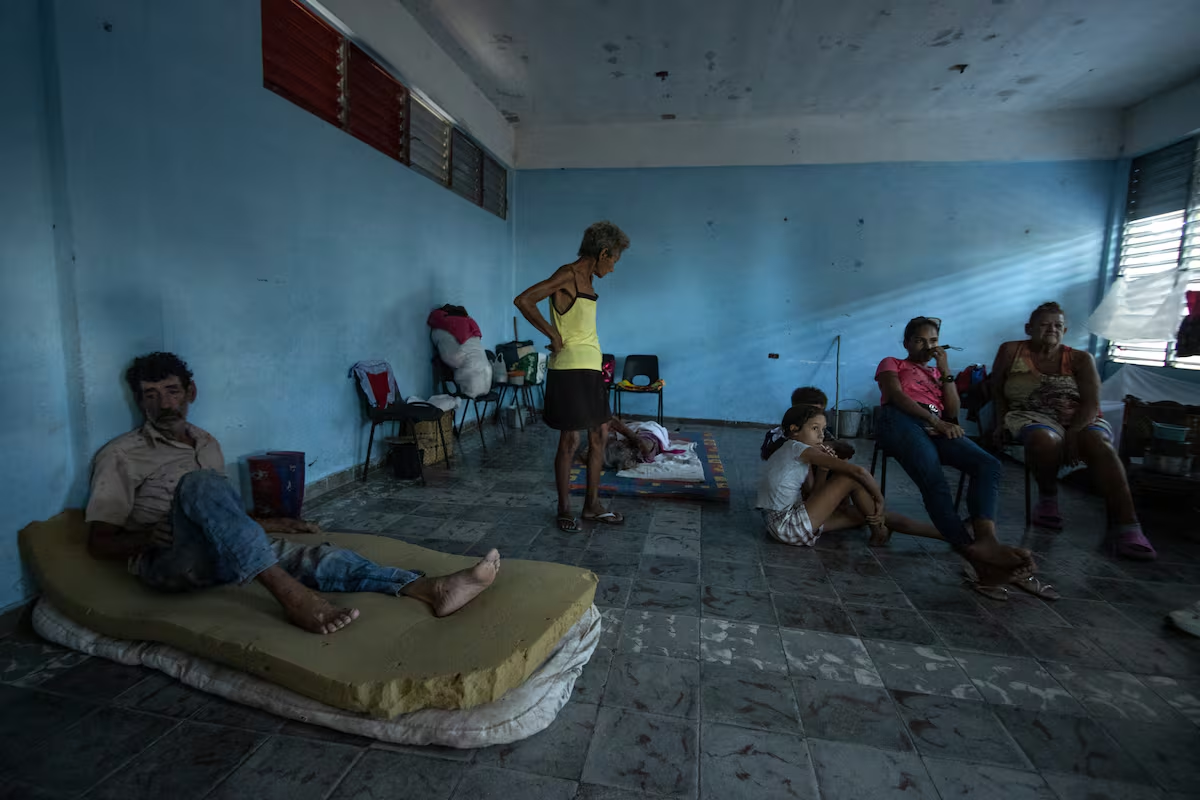The lives that Hurricane Melissa upturned in Cuba

The smell of death permeates Cauto el Paso. The stench emanating from the remains of horses, goats, cows, and pigs has overtaken this town in Granma province for the past two weeks. Located near the Cauto River, the most voluminous in Cuba, this waterway — far from living up to its name — overflowed its banks in the early hours of October 31, following the passage of the powerful Hurricane Melissa. The carcasses appear along the road at regular intervals, tangled in the thick mud left by the floods that submerged the area for several days. They are a stark reminder of the helplessness of the inhabitants of this eastern region of the island, so dependent on their animals, where the hurricane came to take almost everything and further disrupt their already precarious lives.
Around 1 a.m. on the last day of October, after the hurricane had already passed through the island and was continuing its journey across the Caribbean, some residents of Cauto el Paso noticed that the water was reaching levels they hadn’t seen in the last 50 years. They alerted one another, and a race against time began to protect their belongings, moving them to the upper floors of their houses and even onto the roofs. Everyone had expected the hurricane to damage their homes, to blow off some roofs, but no one had warned them of the possibility of flooding. With no other option, the residents of Río Cauto and Cauto Cristo scrambled to save their own lives and took shelter, waiting to be evacuated by Cuban civil defense workers.
According to the United Nations mission in Cuba, Hurricane Melissa affected more than 3.5 million people, damaged or destroyed 90,000 homes, and damaged around 100,000 hectares of crops. Unlike other Caribbean islands, such as Haiti and Jamaica, where the hurricane claimed dozens of lives, no casualties were reported as Cuban authorities — who are accustomed to dealing with these types of storms every hurricane season — had evacuated nearly a million residents from the east of the island. But just when things were already chaotic in the lives of Cubans, between rampant inflation, the high cost of living, the spread of mosquito-borne diseases, unsanitary conditions, and constant power outages, the cyclone arrived to stir things up even more.
A woman draws water from a well in eastern Cuba, this November.Marcel Villa
More than two weeks after the storm, families who have lost everything now face the challenge of rebuilding under the burden of the pre-existing food, fuel, and medicine shortages on the island, disoriented by how to restart their lives under these circumstances. The UN has stated that Cuban authorities are “overwhelmed” by the devastation caused by Melissa.
In Cauto el Paso, with the waters now receding, families have been returning to their homes, almost all of which are still standing but submerged in thick, damp mud. The only way to reach the village is by tractor, one of the few vehicles that can travel the road without getting stuck in the mud left behind by the floodwaters, which cut off the community.
Aid that does not solve the problems of the victims
The streets are a makeshift stall of disassembled electrical equipment and mattresses drying in the sun. “I still don’t know if all that stuff I have in the sun still works, and I have things inside that I won’t be able to put out. What’s the point of so much sun? If they work, great, and if not, we’ll see,” says Elisa Batista, the 28-year-old librarian at the Cauto el Paso school, on the porch of her wooden house with a zinc roof. Batista, who lives with her young daughter, disassembled the frame of her bed and put the mattress in the sun, along with the little girl’s books and the television set. They’ve been doing this for five days. Like her, everyone in the community was expecting the typical damage from the strong wind and rain, so they took down everything that was up high for fear of losing their roofs. “They didn’t tell us anything about flooding, otherwise we would have moved our things to higher ground,” the young woman laments.
The situation is critical in communities like Cauto el Paso, where pre-existing poverty has been exacerbated by a lack of basic resources. External aid has begun to arrive, and various countries, multilateral organizations, and United Nations agencies have channeled material resources, funds, and technical assistance to the areas hardest hit by the hurricane. Fernando Hiraldo del Castillo, resident representative of the United Nations Development Programme (UNDP) in Cuba, told EL PAÍS that his team is working in the affected areas, delivering supplies such as tarpaulins, metal roofing sheets, tool kits, chainsaws, and generators “so that people can repair the basic conditions of their homes after the storm, as well as mobilizing funds for subsequent recovery efforts.”
The inhabitants of the Río Cauto municipality receive humanitarian aid.Marcel Villa
One of the initiatives that recently delivered resources — food, clothing, appliances, and rechargeable lamps — to areas affected by the floods was the “Río Cauto in Our Hands” caravan, made possible through the collaboration of members of civil society, international donors, and Cuban private companies, with the approval of local authorities. The convoy departed from Havana to Granma, an 18-hour trip coordinated by Leniuska Barrero, a resident of the capital for several years but originally from this eastern region. Throughout the trip, she reiterated that this aid wouldn’t solve all the problems faced by the victims of the Melissa floods, but it would at least bring some relief and address specific needs for some people.
As evening falls, the volunteers arrive at one of the homes where social workers have identified one of the most vulnerable families in the area, among the many elderly people living alone, people with physical or intellectual disabilities, or single mothers with more than three children. They bring these families extra supplies. Yaimilín is 21 years old and pregnant with her fourth child. She and her young children greet the visitors barefoot, covered in mud up to their knees. There’s little room on the mother’s face for joy when she receives the donations, although she is grateful. When someone asks her how she sees her future, if she thinks about leaving Cauto el Paso someday and starting a new life, she just shrugs and says, “I’ve always lived here.”
“A hole we need to get out of”
About five miles north of Cauto el Paso lies the community of Grito de Yara, named after a now-defunct sugar mill that once fueled the economy of the residents who live in apartment buildings. It’s barely 7 p.m., and darkness and mosquitoes reign supreme. For more than two weeks now, electricity has been a thing of the past after sunset. Amid the darkness, a single light stands out, drawing dozens of people. It’s the polyclinic, where a generator has been set up to power electrical devices. People come every afternoon to plug in their cell phones, lamps, or portable fans. While the generator is running, residents can connect to the internet until around midnight, when the town once again descends into silence.
A flooded street in Grito de Yara, Cuba.Marcel Villa
With the first rays of sunlight, people return to the streets of this village to try to secure the basics to survive another day: from a jug of cow’s milk for breakfast to green plantains that a farmer is selling from his cart. Some people go out with their axes to chop down the first tree they find to make firewood for cooking, because a sack of charcoal costs 1,000 CUP (almost half the minimum wage), when it’s available, and many people can’t afford it. In a Cuba plagued by blackouts, this has become a common way to cook for many.
As evening falls, the procession of buckets and jugs begins, searching for water, a resource that arrives murky when it reaches the cisterns. There are some cooperatives that have managed to get a water truck on request in other areas. Some people have had to buy a bucket of water for 500 CUP so as not to run out of drinking water. This is what Yunior, a 46-year-old agricultural engineer and second in command of one of the agricultural cooperatives in the area, has done. He lives in an apartment with his mother, wife, and sister and considers himself lucky in the face of disaster. Before Melissa hit, he had time to sell his pigs and harvest the rice that is now piled up in sacks inside his home. But the hurricane destroyed his sweet potato crops and 30 hectares of sugar cane.
“What happened here was criminal,” says Yunior, referring to the floodwaters that inundated the streets of Grito de Yara around dawn on October 31, traces of which can still be seen. “This isn’t just the overflowing river. It’s sewage,” warns the farmer’s mother. Prior to the hurricane, they explain, the necessary work to clean up the waste and sewage tanks was not carried out, at least in their building, despite the fact that they had been asking the authorities to do so for months. With the flooding, the waters mixed together and now cover the entire street where two apartment buildings stand, like a giant mosquito-breeding pool, mingling with the sewage-filled ditches that run throughout the town.
Very close by is the Grito de Yara primary school, now converted into an evacuation center, where residents from other villages still affected by flooding, such as El Aguacate, Las Ova, Saladillo, and El Palmar, are staying. Their houses, made of wood with zinc roofs, some of masonry, remain submerged, so the residents continue to spend nights in the classrooms of this school, sleeping on mats or directly on the floor.
A woman next to furniture destroyed by the hurricane.Marcel Villa
There waits Nubia, 43, eager to return to see what’s left of her house in El Aguacate, where her husband has already been and seen that there’s not much to salvage. “Nobody expected these floods,” says Enrique Castillo, a 57-year-old baker who owns a house with land for farming, right across from the school. Melissa swept away his tomato crops and 23 of his 25 beehives, but left him with his rice fields. Enrique shows the mark of how high the water reached during the floods — about a meter — while offering a clear reflection on his future plans: “This area is a hole I have to get out of. I’m fighting to leave, because things are complicated.”
The dismay is palpable in these areas after the effects of Melissa, and residents don’t see a very promising future, so many are considering migrating. Yunior, the agricultural engineer, thinks he’ll be living somewhere else within a year. “Everyone here is migrating,” he says. “At the cooperative, all the staff are from somewhere else; besides, where the food comes from [the fields], people don’t want to work anymore. I don’t think things will recover in a year.”
Sign up for our weekly newsletter to get more English-language news coverage from EL PAÍS USA Edition





